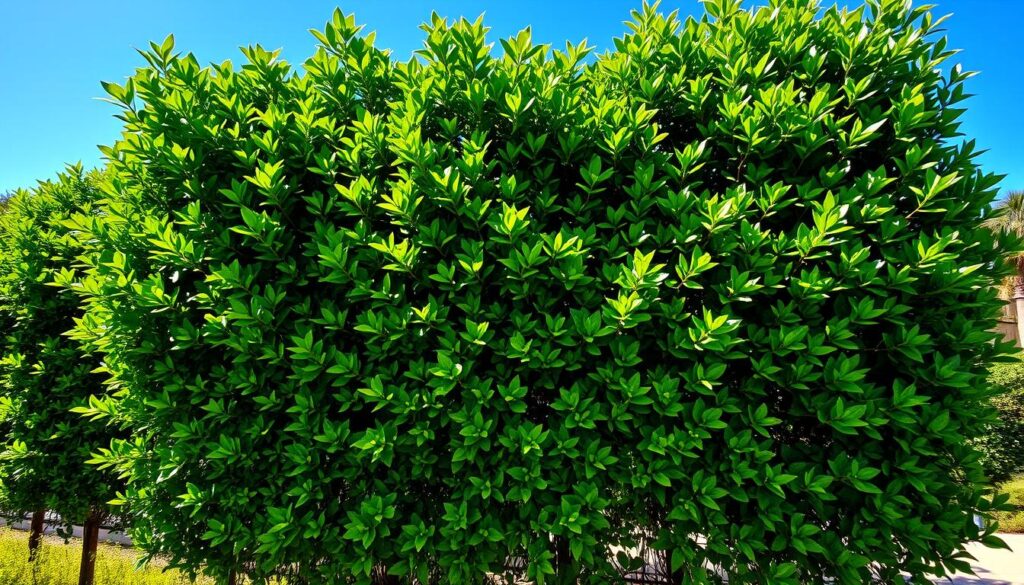In Southern California, privacy hedges are in high demand. Homeowners want to block out street traffic and nosy neighbors. The ficus hedge tree is a top pick for natural privacy screens. It turns any backyard into a private, Hollywood-style retreat.
Ficus hedge trees are known for being tough and easy to care for. They fit well in many climates. These plants can grow up to 25-30 feet tall, making a lush barrier around your property.
Key Takeaways
- Ficus hedge trees offer a natural, lush solution for creating privacy screens in outdoor spaces.
- They are known for their resilience, adaptability to various climates, and ease of maintenance.
- Ficus hedges can grow up to 25-30 feet tall with a 35-40 feet spread, providing a dense and versatile privacy barrier.
- These fast-growing trees are a popular choice for homeowners seeking both privacy and aesthetic appeal in their landscaping.
- Ficus hedge trees are a sustainable and low-maintenance option for creating a private, secluded outdoor oasis.
Understanding the Hollywood Hedge: Introduction to Ficus Nitida
The Ficus nitida, also known as the Indian Laurel Fig, has a rich history in landscaping. It’s especially popular in Southern California’s sunny weather. It became known as the “Hollywood hedge” for its use in celebrity homes to create lush screens.
Historical Significance in Landscaping
Ficus nitida is known for its dense, green foliage and quick growth. It’s perfect for creating elegant privacy barriers. Its ability to grow well even after frequent pruning made it a favorite among landscape designers.
Natural Features and Characteristics
The Ficus nitida has unique features that make it a top choice for hedges. Its dense, glossy leaves and fast growth rate are ideal for privacy screens. It also thrives in various climates.
Climate Adaptability
Ficus nitida is very adaptable to different climates. It does well in full sun to partial shade and can handle drought and heat. It grows well in zones 8 to 10, covering much of California and the deep South. Its low-maintenance nature makes it a favorite for privacy solutions.
“Ficus nitida hedges are popular for creating privacy screens due to their dense foliage, fast growth rate, and lush, green appearance.”
Benefits of Choosing Ficus Hedge Tree for Privacy
The Ficus hedge tree is a top pick for a privacy screen. It grows fast, reaching 4-6 feet a year. This makes it quick to create a solid barrier.
The ficus tree benefits include its dense, evergreen leaves. These leaves block views and reduce noise. They also add a tropical look to your yard. Plus, the tree is easy to care for, perfect for those with little time or gardening skills.
The ficus landscaping also helps the environment. It cleans the air by removing harmful chemicals. It also offers a home for local wildlife. Whether you need a privacy hedge or a decorative piece, the Ficus hedge tree is a great choice.
| Ficus Hedge Tree Benefits | Details |
|---|---|
| Rapid Growth | Some varieties can grow up to 4-6 feet per year, allowing for quick privacy establishment. |
| Dense Foliage | Provides excellent visual screening and noise reduction with its glossy, dark green leaves. |
| Low Maintenance | Requires minimal care once established, making it ideal for busy homeowners. |
| Environmental Benefits | Improves air quality by removing harmful chemicals and provides habitat for local wildlife. |

“The Ficus hedge tree is an exceptional choice for creating a lush, visually appealing privacy screen that offers numerous practical and environmental benefits.”
Optimal Growing Conditions and Requirements
The Ficus hedge trees can grow well in many conditions. But they do best when they have the right soil, sunlight, water, and temperature. Knowing what they need helps keep them healthy and looking great.
Soil Requirements
Ficus hedge trees like soil that drains well. They can grow in different soils but prefer slightly acidic to neutral pH. Regular fertilizing during the growing season helps them stay green and grow strong.
Sunlight and Water Needs
Ficus hedge trees need full sun to partial shade. They can handle some shade but grow best in the sun. They need consistent moisture, especially when they’re young. But once they’re grown, they can handle some dry spells.
Temperature Preferences
Ficus hedge trees can handle a wide range of temperatures. They can even survive down to about 20°F. But they grow best in warm weather, above 60°F. The best temperature is above 70°F.
“Maintaining the right balance of soil, light, and moisture is crucial for the long-term success of Ficus hedge trees as a natural privacy screen.”
By giving Ficus hedge trees the best growing conditions, gardeners can make them thrive. This creates a beautiful and lasting privacy screen for outdoor areas.
Planning Your Ficus Privacy Screen
Creating a stunning ficus privacy screen requires careful planning. You need to think about the trees’ mature size and how they grow. Make sure you have enough space for their roots and leaves to spread out.
Decide how tall and dense you want your screen to be. This will help you figure out how far apart to plant the trees. They should be 2 to 4 feet apart for a solid look. Also, check local laws about hedge height and placement.
When planning your landscape, think about how fast ficus trees grow and how much care they need. Place the trees wisely to make a balanced hedge design. A bit of planning can help you achieve your dream ficus privacy screen.
| Ficus Variety | Growth Rate | Mature Height | Spacing Recommendation |
|---|---|---|---|
| Ficus Nitida | 2 feet per year | 5-20 feet | 2 feet apart |
| Ficus Koh | 1-2 feet per year | 10-15 feet | 3 feet apart |
| Ficus Hillii | 1-2 feet per year | 15-20 feet | 4 feet apart |
By understanding the unique traits of different ficus trees, you can plan your landscape better. This will make your ficus privacy screen look great and improve your outdoor area.
“Properly managed Ficus trees are not problematic, with hundreds of thousands planted in Melbourne without causing issues.”
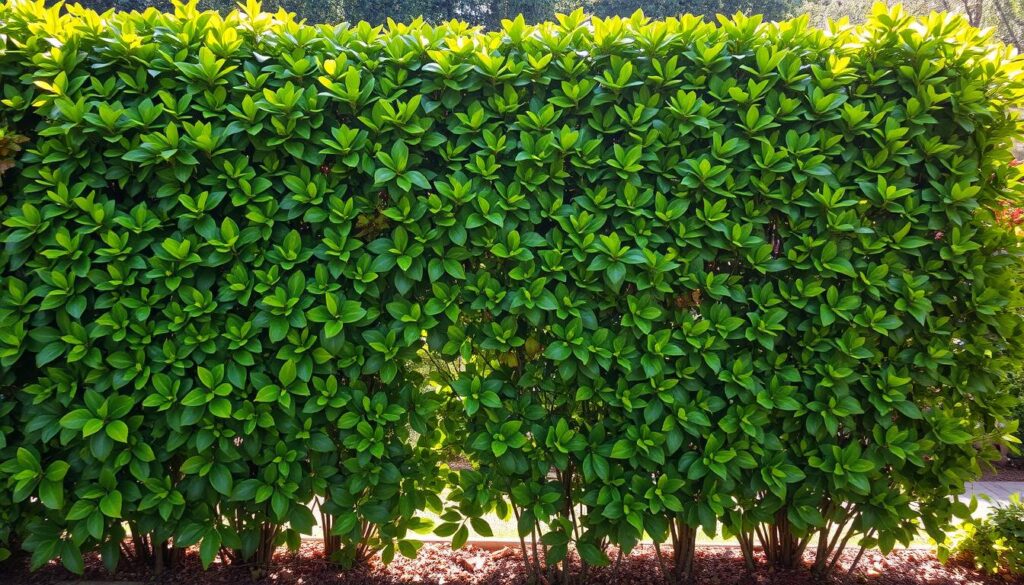
Proper Spacing and Planting Techniques
Creating a lush Ficus hedge requires the right spacing and planting methods. Knowing the best distance between plants and following planting depth guidelines is key. This ensures your ficus planting project will flourish.
Distance Between Plants
For a dense Ficus hedge, plant trees 1.5 to 2 feet apart. This close hedge spacing helps plants grow together, creating a solid barrier. If you want larger trees, space them 3-4 feet apart.
Planting Depth Guidelines
When planting your Ficus hedge, dig holes twice as wide as the root ball and at the same depth. Make sure the root ball’s top is level with or slightly above the soil. Fill with native soil, water well, and add mulch around the base. Keep mulch away from the trunk.
Proper spacing and planting depth are vital for a healthy, thriving Ficus hedge. They ensure your hedge will provide privacy and beauty for many years.
Growth Rate and Size Expectations
Ficus hedge trees grow fast and get big. They can grow 4-6 feet each year. This makes them great for a tall, lush privacy screen.
Ficus nitida hedges can grow up to 30 feet tall if not pruned. But, they’re usually kept between 8-15 feet tall for a formal look. Their width can also be controlled by pruning, but unpruned trees can spread 15-25 feet wide.
The ficus growth rate and hedge size can change based on climate, soil, and care. With the right care, you’ll see a privacy screen in 2-3 years. It will reach full size in 5-7 years.
“Our apartment complex decided to invest in a lush Ficus hedge to create a sound barrier and privacy screen for our residents. The growth rate has been incredible, and we now have a 20-foot-tall, 15-foot-wide hedge that provides a beautiful and functional landscape feature.”
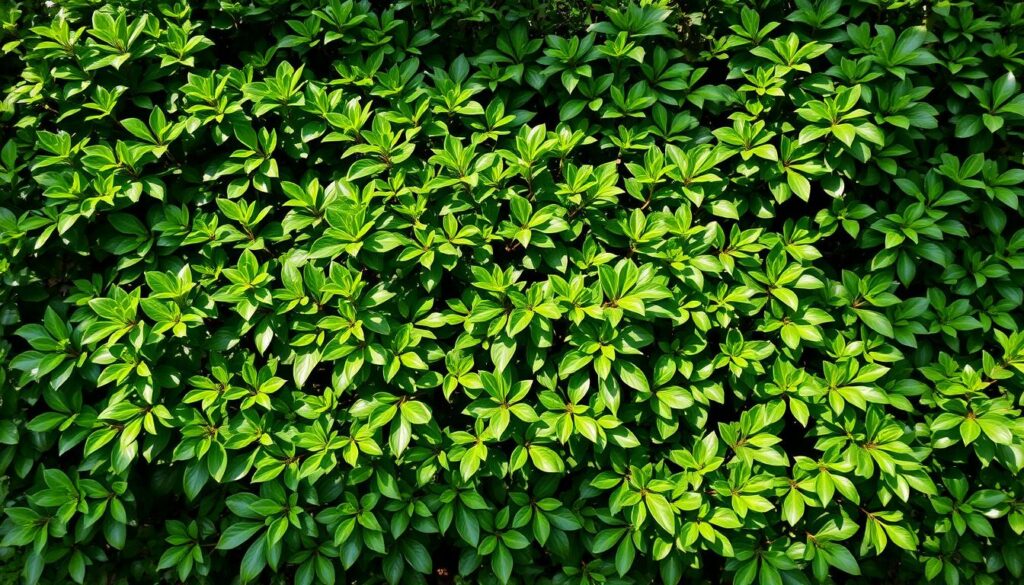
Knowing how fast ficus grow and how big they can get helps with planning. Homeowners and landscapers can make better choices for their privacy screens and hedges.
Essential Care and Maintenance Tips
Proper care is key for a healthy ficus hedge. Understanding their specific needs is crucial. Here are the essential tips to keep your ficus hedge thriving.
Watering Schedule
Water your ficus hedge deeply and often, especially in the first year. Once established, water deeply once or twice a week in dry periods. Adjust based on climate, soil, and hedge size.
Fertilization Requirements
Fertilize in spring and mid-summer with a balanced, slow-release fertilizer. This supports growth and lush foliage. Always follow the fertilizer packaging for correct application.
Regular pruning, pest monitoring, and seasonal care adjustments are also vital. By adapting to your ficus plants’ needs, you’ll keep your hedge maintenance thriving.
“Ficus trees are known for their resilience and adaptability, but proper care is essential to keep them thriving in any environment.”
The watering schedule and fertilization requirements can change with the ficus species, climate, and conditions. By listening to your ficus hedge’s needs, you’ll enjoy a lush, private oasis for years.
Professional Pruning and Shaping Methods
Maintaining an attractive Ficus hedge needs expert ficus pruning and shaping. Start shaping young plants early for dense growth. Prune 2-3 times a year to keep the right height and width.
Use sharp tools for clean cuts just above leaf nodes. For formal hedges, guide strings help keep lines straight. Thin out interior branches for better light.
Don’t prune too much in late fall or winter in cold areas.
Arborists say not to remove more than 25-30% of foliage at once. This keeps the plant healthy. Thinning cuts help shape young trees and control growth.
When cutting small branches, cut back to ¼-inch above a vigorous bud. For larger branches, use a thinning cut to seal wounds. For limbs over 2 inches, use the three-cut method to avoid bark damage.
Proper professional trimming keeps hedges healthy and looking good. The right tools make maintenance easier. Prune at the right time to keep the hedge healthy.
The three-year rule helps rejuvenate overgrown hedges. Shaping techniques like the upside-down V shape affect growth.
“Topiary, an advanced maintenance technique, requires ongoing attention for stunning results.”
Watering and mulching keep hedges alive. Balanced fertilization supports growth. Organic fertilizers are good for the environment.
Pests and diseases can harm hedges. Yellow or brown leaves might mean nutrient issues or winter damage.
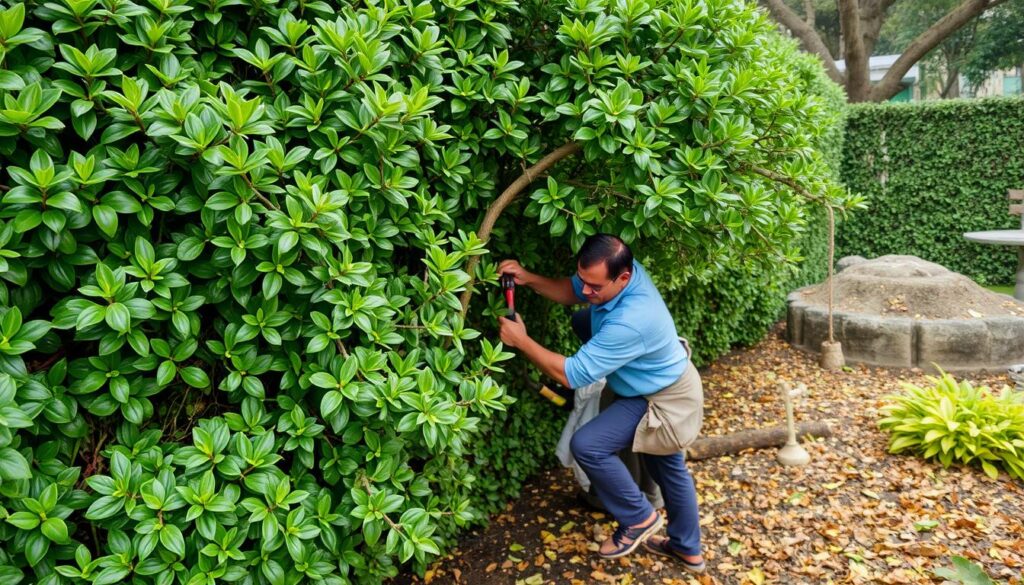
Boxwood and yew are good for formal hedges. Hydrangea and lilac are better for informal ones. Proper care makes a Ficus hedge look great and provide privacy.
Common Pests and Disease Management
Ficus hedges are generally hardy but can face pests and diseases if not cared for. Knowing common issues and using proactive treatments helps keep your ficus hedge healthy and looking great.
Identifying Problem Signs
Common problems include whiteflies, aphids, and fungal diseases. Look for yellow leaves, leaf drop, or insects. Regular checks can help catch and fix problems early.
Treatment Solutions
To fight whiteflies and aphids, use insecticidal soap or neem oil. These methods are safe for the plant. For fungal diseases like Anthracnose, Botrytis blight, or Corynespora leaf spot, improve air flow and avoid overhead watering. If needed, use a fungicide.
Root rot, caused by poor drainage or too much water, is another issue. Good drainage and avoiding too much water are key to preventing it.
Regular checks and quick action are vital for your ficus hedge’s health. By being proactive, you can enjoy your ficus hedge’s beauty and privacy.
| Pest/Disease | Symptoms | Treatment |
|---|---|---|
| Whiteflies | Yellowing leaves, leaf drop | Insecticidal soap, neem oil |
| Aphids | Yellowing leaves, leaf drop | Insecticidal soap, neem oil |
| Anthracnose | Greasy-appearing spots, yellow halo | Avoid overhead watering, apply fungicide |
| Botrytis blight | Leaf and flower damage during cool, damp periods | Improve air circulation, use fungicide |
| Corynespora leaf spot | Small to large reddish leaf spots | Fungicide application |
| Root rot | Wilting, yellowing leaves | Ensure proper drainage, avoid overwatering |
Root System Management and Control
When planting a ficus hedge tree, managing its roots is crucial. Ficus trees have invasive roots that can harm nearby structures, pipes, and other plants.
To control the ficus roots, start with proactive steps during planting and maintenance. Installing root barriers near buildings or utilities is a good idea. These barriers keep the roots from damaging structures.
Regular root management through pruning is also key. Pruning the tree’s canopy helps limit root spread. This way, the tree focuses on growing above ground rather than underground.
Don’t plant ficus trees near foundations, pipes, or septic systems. Their roots can damage these over time. If pruning is needed, get a professional arborist to avoid harming the tree.
With these strategies, you can manage and control the ficus roots. This ensures your privacy hedge grows well without harming your property or landscape.

“Proper root management is the key to a healthy and well-behaved ficus hedge.”
Seasonal Care Guidelines
To keep your ficus hedge healthy, adjust your care routine with the seasons. Follow these guidelines to ensure your ficus plants stay vibrant. This way, they’ll keep your outdoor space private and green.
Spring: Reviving Growth
Spring is when your ficus hedge grows most. It’s the best time to use a balanced, slow-release seasonal ficus care fertilizer. This gives your plants the nutrients they need for lush leaves. Make sure to water more often, but don’t soak the roots.
Summer: Protecting from Heat
In the summer, your ficus hedge needs extra care. Water it about 1 inch each week. Keep an eye out for pests like spider mites and mealybugs. Use insecticidal soap or neem oil if you find any.
Fall: Preparing for Dormancy
As autumn comes, start watering less and prune lightly. This helps your ficus hedge get ready for the winter protection and its dormant phase.
Winter: Protecting from Frost
In cold areas, protect your ficus hedge from frost. Use frost cloth or organic mulch to keep the roots warm. Water less, but don’t let the soil dry out.
Adjusting your seasonal ficus care to the seasons ensures your hedge thrives all year. It will keep your outdoor space green and private.
| Season | Key Care Tasks |
|---|---|
| Spring |
|
| Summer |
|
| Fall |
|
| Winter |
|
“With proper seasonal care, your ficus hedge will thrive and provide lush, evergreen privacy year-round.”
Comparing Ficus to Other Privacy Hedge Options
Ficus hedges are a top choice for a natural privacy screen. They grow fast and have lots of leaves. But, it’s good to compare ficus to other options to choose the best for your yard.
Cost Comparison
Ficus hedges might cost more to start, but they grow quickly. This means you see results fast. Other plants like Italian Cypress or Podocarpus are cheaper but take longer to grow tall enough for privacy.
In the long run, ficus hedges are worth it. They quickly change your yard’s look, even if they cost more at first.
Maintenance Requirements
Ficus hedges need regular trimming to keep their shape. They are more work than non-living screens like fences. But, they are beautiful and good for the environment.
Other fast-growing plants like bamboo can spread too much. Plants like oleander are even poisonous. So, think about how much work you want to do when picking a hedge.
When looking at privacy hedge options, think about how fast they grow, how much care they need, and if they like your climate. Ficus hedges are a great choice for those who want a quick, beautiful, and easy-to-care-for privacy screen.
| Hedge Option | Growth Rate | Maintenance Needs | Suitability |
|---|---|---|---|
| Ficus | Fast (up to 2 meters per year) | Moderate (regular pruning required) | Suitable for warm climates, tolerant of poor soil and drought |
| Italian Cypress | Slow (up to 0.5 meters per year) | Low (occasional trimming) | Suitable for Mediterranean and warm climates, intolerant of heavy frost |
| Podocarpus | Moderate (up to 1 meter per year) | Low (occasional trimming) | Suitable for mild climates, tolerant of partial shade |
| Bamboo | Fast (up to 2 meters per year) | High (aggressive growth control required) | Suitable for warm climates, can be invasive in certain regions |
| Oleander | Fast (up to 1.5 meters per year) | Moderate (regular pruning required) | Suitable for warm, coastal climates, but toxic if ingested |
The table above shows how different privacy hedge options compare. It helps you decide which hedge options are best for your privacy hedge comparison.
Environmental Impact and Benefits
Ficus hedges are great for the environment, making them a smart choice for green landscaping. They clean the air by removing carbon dioxide and adding oxygen. This helps make the air we breathe cleaner.
These plants also create homes for birds, insects, and other wildlife. This supports the local ecosystem and helps keep biodiversity strong.
In cities, Ficus hedges can help block out noise and keep temperatures down. Their roots also stop soil from washing away. This makes them a key part of eco-friendly landscaping.
Even though Ficus hedges might not be from around here, they can still be part of sustainable gardening. They grow well in many places and look good all year. This makes them a favorite for those who want to make their outdoor spaces more eco-friendly.
| Environmental Benefit | Impact |
|---|---|
| Air Purification | Absorbs carbon dioxide and releases oxygen, improving air quality |
| Habitat Creation | Provides shelter and food for local birds, insects, and wildlife |
| Noise Reduction | Helps mitigate noise pollution in urban areas |
| Urban Heat Island Effect | Reduces the absorption and retention of heat in urban environments |
| Soil Erosion Prevention | Extensive root systems help stabilize the soil and prevent erosion |
Using eco-friendly hedges like Ficus in green landscaping helps the environment. Homeowners and property managers can make their outdoor spaces more sustainable.
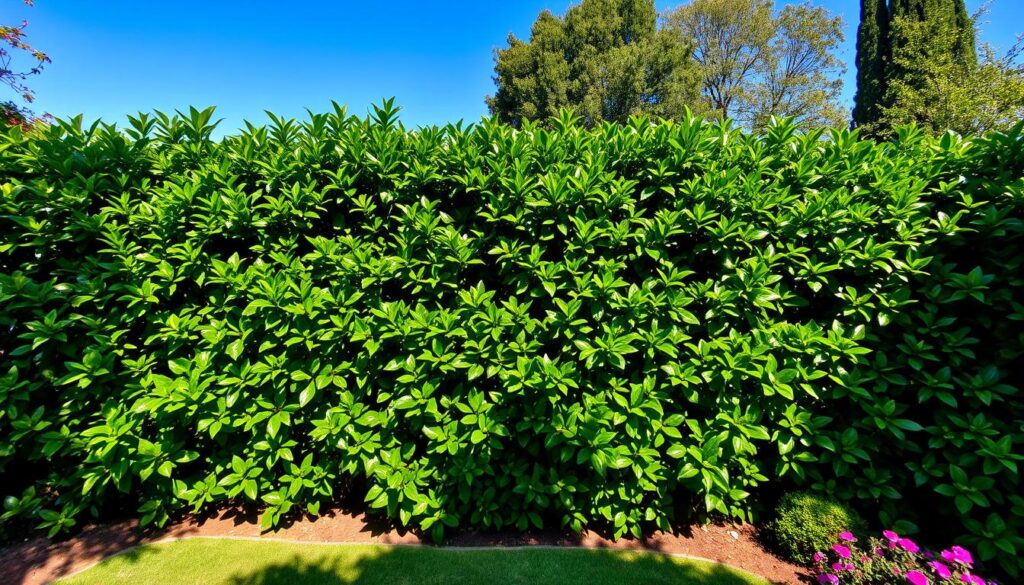
Conclusion
Ficus hedge trees are great for making natural privacy screens. They grow fast, have thick leaves, and fit well in many climates. This makes them perfect for improving outdoor areas.
Even though Ficus hedges need regular care, their beauty is worth it. They not only hide views but also make your yard look better and help the environment.
With the right planning and care, a Ficus hedge can last a long time. It adds beauty and function to any property. Knowing how to handle Ficus trees helps ensure your privacy screen works well.
In summary, Ficus hedges are a top pick for natural beauty and privacy. They offer many benefits, from enhancing your yard to creating a peaceful space. They are a smart choice for anyone looking to improve their outdoor area.
